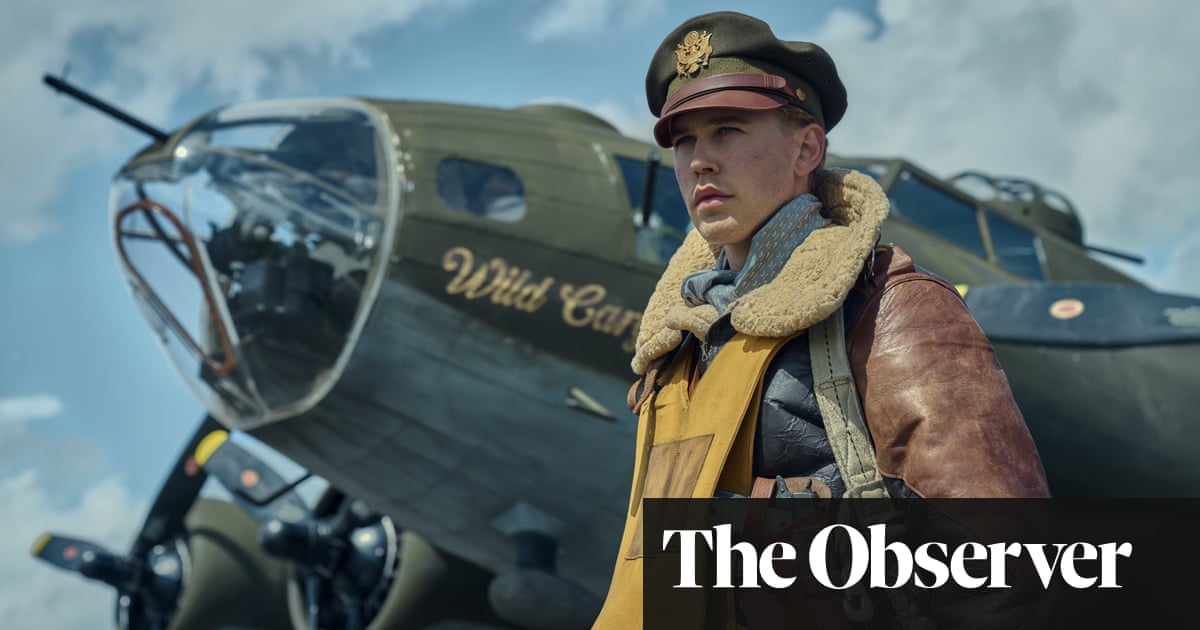
There’s a peaceful, almost austere beauty to the Suffolk countryside that seems a world away from the stories of war and destruction that dominate the news. But as Masters of the Air, the new Apple TV drama about American airmen in the second world war, reminds us, 80 years ago this sleepy corner of England played host to the Anglo-American aerial assault on Nazi-controlled Europe.
The show focuses on the Eighth Air Force’s 100th Bomb Group, stationed at Thorpe Abbotts. But there were more than 50 US bases in East Anglia in the second half of the war, and each had its legends and tragedies.
The frighteningly high attrition rate in the Bloody 100th meant the chance of surviving a tour of 25 missions was close to zero. But anywhere in the Eighth Air Force was a dangerous place to be: 73% of the men who flew were casualties, either injured or killed.
A few miles down the road from Thorpe Abbotts was Halesworth, home to the 489th Bomb Group, the 56th Fighter Group, which boasted a combat performance unequalled in US airforce fighter history, and the 5th Emergency Rescue Squadron.
There is scarcely any sign of the old airfield now, which is mostly occupied by a Bernard Matthews (of “bootiful” turkey fame) factory.
There is, however, the rather amazing Halesworth Airfield Memorial Museum that commemorates the lives, and not infrequently deaths, of the young Americans stationed at Halesworth and elsewhere in Suffolk.
It’s run by a local, Richard Pymar, with various volunteers, and holds a wealth of artefacts and extraordinary stories. There is a display about Joseph Kennedy Jr, elder brother of the future president, whose plane exploded on a secret mission a few miles south of here – the plane accompanying it emergency landed at Halesworth.
There’s another of the band leader Glenn Miller, who performed at the base in August 1944, a few months before he was lost over the Channel. There are also many photographs of a dashing officer called Dave Schilling, a flying ace with more than 20 kills, who commanded the 56th Fighter Group, had an affair with a lady of the manor, and at 25 was made a colonel – the air force rewarded experience, and the experienced were the young.
Schilling survived 132 combat missions but was to die in a car crash in a Suffolk country lane, 11 years after the war ended.
There are so many similarly sad tales, but also memorably uplifting ones. The Americans often formed strong bonds with the locals, many falling in love, marrying and taking their wives home to the States. In other cases they left behind pregnant women.
One woman knew that her biological father was an American pilot and looked in vain for him for 50 years. About 10 years ago, Pymar spent three days investigating and found James Strunk.
“When his wife died – he didn’t want her to know anything about it – he came over and saw [his daughter], and she went over to America as well,” says Pymar.
Many other American airmen who survived the war have also paid visits, though most are now dead. Most, but not all: John “Lucky” Luckadoo, who flew with the Bloody 100th, visited two months ago.
He completed 30 missions in a B-17 Flying Fortress – his nickname was much more than a diminutive – and he returned last October aged 101.
“He’s a lovely man,” says Pymar. “And his mind and memory are still pin-sharp.”
Masters of the Air is executive-produced by Steven Spielberg, and after Band of Brothers and The Pacific, it completes a trilogy about the Americans in the second world war. One of its strengths is conveying how terrifying it was to be on a sortie to France, Holland, Norway or Germany.
Because the pilots and crew were usually so young – the average age of fighter pilots was about 21 or 22 – there is a youthful glamour attached to their heroic deeds.
In reality almost everything about a mission was awful. The planes were cramped, often flying in cloud where close formations risked crashing into each other, and the temperature was so cold that frostbite was common, particularly if someone had to remove their gloves. And that was all before they encountered the enemy.
After 1943, the Americans took over from the British in flying daytime missions. (The British had sustained appalling losses, as the Americans were to do, and thereafter focused on night raids.) The bonus of flying during the day was that it was easier to see the target. The drawback, of course, was to be more easily spotted by German guns and fighters.
In the first episode of Masters of the Air a confident young pilot returns traumatised after his first mission, in which three bombers are shot down and 30 men lost. “Why didn’t you tell me?” he asks a friend, who had been on two missions but not shared the horror.
Pymar says of returning American airmen who have recounted their experiences: “A lot of them say that they were scared.” His friend and fellow volunteer Paul Starks adds: “They say, if you weren’t scared there was something wrong.”
Luckadoo told them that after flak opened a hole in his plane a cold airstream froze his foot to the pedal. “He managed to land back at Thorpe Abbotts and they took him to hospital and put his foot in ice cold water and slowly thawed it,” says Starks.
That kind of hardship was largely taken by airmen in their stride. If they managed to complete their missions and return to America, they would often keep their ordeals to themselves.
“Sometimes they came back here with their families,” says Starks, “and all of a sudden they were telling them things they’d never heard before, because everything they saw here reminded them of those times.”
In one respect the Americans fared well, with their relative wealth and superior diet in a country with strict rationing. But they were also many thousands of miles from home, risking their lives to protect a country most had never seen before.
Outside the museum, the sky is an aviator’s dream, there is a soft breeze and birdsong in the trees. We stand at the three memorials on the lawn to the 56th, 489th and 5th and Pymar tells the story of bombardier Dick Wagner and his friend Norman Kanwisher, a navigator, who came to reunions at Halesworth.
Norman liked to remind Dick of the day his friend returned from a mission with two bombs stuck in the bomb bay. The pilot told Dick to hug the bombs to lower the risk they would vibrate and explode.
“Dick said: I had what they call a ‘laundry problem’,” says Pymar, laughing. “He shit himself.”
More sombrely, he adds: “Both Dick and Norman were cremated, and they had their ashes spread here.”
The japes and nostalgia aside, it’s hard to imagine the levels of fear and anxiety those young men had to overcome. But we should be eternally grateful they did.












